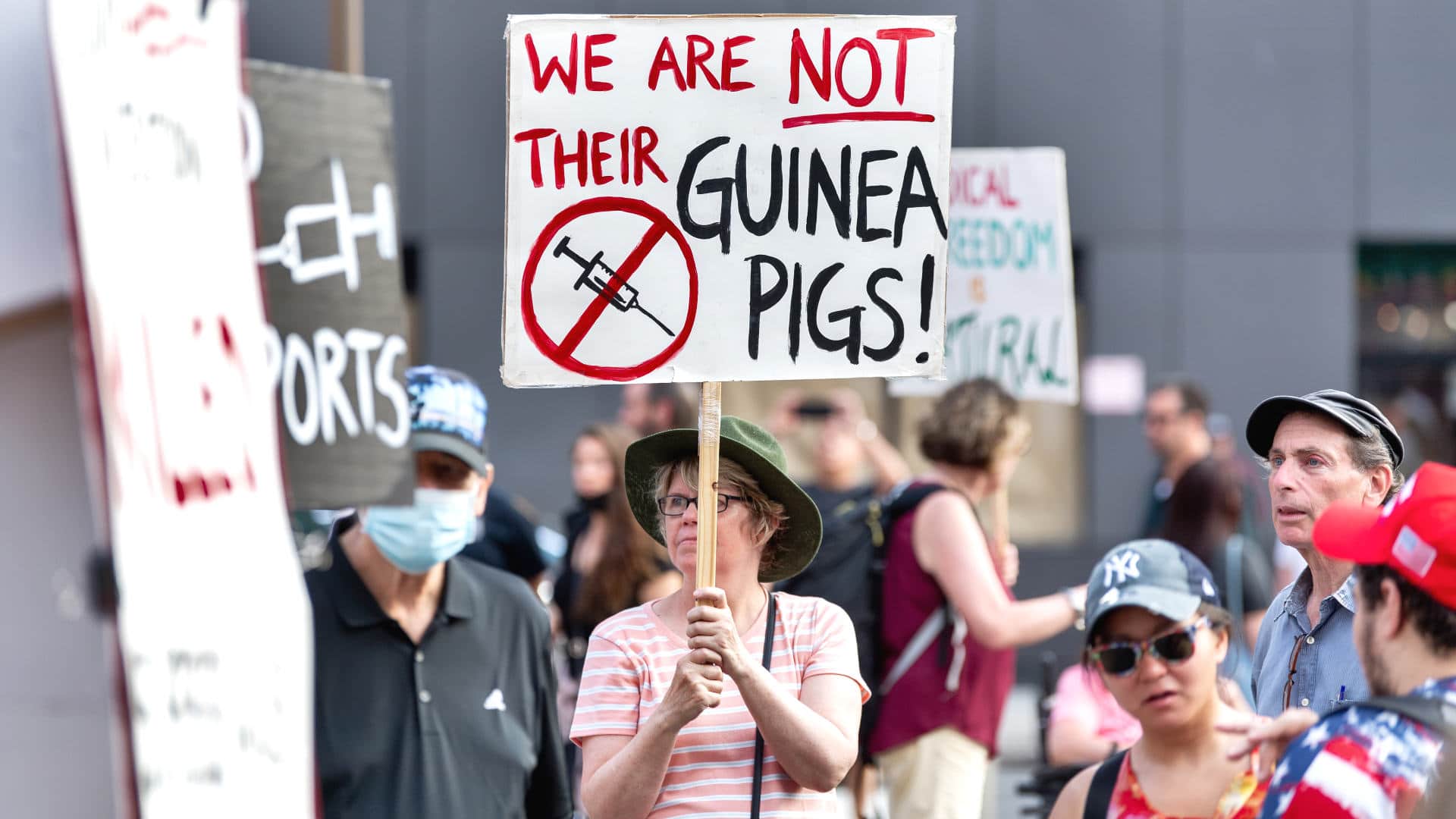In May, the late-night show “Jimmy Kimmel Live!” aired a public service announcement that told viewers to “grow the f*ck up” and take the Covid-19 vaccine. In the clip, a Trump-supporting White woman is belittled for spreading misinformation about vaccination risks via Facebook. Viewers are mocked for listening to her over the advice of health care workers who “are smarter than we are.”
The tone of this PSA is consistent with a broader trend in mainstream media coverage of vaccination rates. Narratives about politically conservative White populations commonly assert that belief in misinformation and conspiracy theories have led these groups to underestimate risk. Articles portray these populations as being anti-science while highlighting absurd examples, such as an individual motivated to reject the vaccine simply for the purpose of trolling the political left. This narrative reveals a remarkable lack of curiosity and empathy regarding the complexity underneath these beliefs. By contrast, articles about unvaccinated minority populations have rightly focused on underlying causes of hesitancy, exploring legitimate grievances such as historical and contemporary racism. Explanations beyond hesitancy are often mentioned, including economic factors, structural barriers, immigration status, and lack of health insurance.
Even essays that strive for nuance often reinforce a moral dichotomy between unvaccinated White conservatives and minorities. A May report from the prominent health analytics firm Surgo Ventures, discussed in a New York Times op-ed, contrasts “Covid Skeptics” (a group Surgo previously labelled “Conspiracy Believers”) with “System Distrusters.” Covid Skeptics hail from states like Arkansas and Alabama — conservative strongholds — and believe theories such as “microchips are implanted with the Covid vaccine.”
On the other hand, System Distrusters come from progressive bastions like Washington, D.C., and Maryland and believe members of their race aren’t treated fairly by the health care system. The op-ed emphasizes that this underserved second group must be reached as a matter of equity. Another New York Times opinion piece notes that “For Republicans, [hesitancy] is connected to a general skepticism of government and science. For Black and Hispanic Americans, it appears to stem from the country’s legacy of providing substandard medical treatment, and sometimes doing outright harm, to minorities.” Although the piece goes on to cite class as a common factor, it nevertheless defines Republicans by the superficial expression of their hesitancy, while Blacks and Hispanics are defined by the underlying source of that hesitancy.
In truth, fringe theories around vaccines have long existed across the political and racial spectrum. The pre-Covid anti-vaccination movement defied polarization, with deep roots in liberal circles. Among the 12 people the Center for Countering Digital Hate and Anti-Vax Watch flagged as most responsible for anti-vaccine online content are members of a range of political and racial backgrounds, including Robert F. Kennedy Jr., Rizza Islam, and Dr. Rashid Buttar. Louis Farrakhan — the head of the Nation of Islam — advised Black people not to take Covid-19 vaccines because of links to Bill Gates and governmental sterilization plans.
Yet, rarely is vaccine hesitancy in minority communities attributed to popular belief in these conspiracy theories and misinformation. Rather than dwelling on these most extreme (often non-representative) examples, journalists take the extra step of looking at context such as the “distrust and social alienation” that foments openness to conspiratorial views. This approach makes sense given that individuals often embrace conspiracy theories because of pre-existing distrust of vaccines or medical systems, not the other way around.
If we take this same nuanced approach with unvaccinated conservative White people — and scratch the surface beneath the conspiracy theory and anti-science explanation even a little — we find that their underlying characteristics are similar to those of unvaccinated minority groups.
Even the label “conservative Whites” is misleading. Class is far more predictive of vaccine hesitancy than either politics or race — with working class White people being twice as likely to be hesitant as White college graduates. Poor White people expressing hesitancy typically have strong religious beliefs, face disproportionate economic and access barriers to vaccination, and have legitimate reasons to mistrust the medical system. Historically, the same sterilization programs that the Nation of Islam members evoke also purposefully targeted poor White people. When Justice Oliver Wendell Holmes, Jr. wrote “Three generations of imbeciles are enough” in a Supreme Court ruling upholding Virginia’s involuntary sterilization law, he was describing a poor White woman with no mental impairment.
More recently, the opioid epidemic ravaged suburban and rural Whites. As detailed in Sam Quinones’ “Dreamland,” the opioid epidemic was caused by the entire health care system pushing painkillers like OxyContin. Mass prescription of opiates has been cited as the core cause of rising mortality among poor Whites, relative to other demographics. Arkansas — the state with the most “Covid Skeptics,” according to the Surgo Ventures report — is second in the nation in dispensing opioids. Other states such as Alabama and Louisiana also significantly exceed the national average on both lists.
Vaccine hesitant conservatives are also disproportionately rural. This creates unique access problems, including shortages of health care workers to administer the vaccines and long driving distances to vaccination sites.
My point isn’t that we should weigh political and racial grievances, or declare that one group’s low vaccination rates are most justified than another’s. (Mortality data alone suggest that ethnic and racial minorities still have the most objective reasons for distrusting the medical system). Rather, my point is that the suspicions felt in Black and Brown communities likely aren’t all that different from the suspicions felt by White people. In each case, focusing on outlandish vaccine conspiracy theories glosses over genuine underlying concerns. In each case, vaccine hesitant Americans are being asked to take a drug developed at unprecedented speed under unfathomable pressure using novel techniques based on short-term studies.
Taking such a vaccine requires trust in the medical system and in society more broadly. Most unvaccinated groups have been let down by both, and a connection can easily be traced between vaccine hesitancy and those failures. That dynamic deserves to be approached with empathy, not ridicule. Unfortunately, the mainstream media seems to be treating some groups as worthy of humanizing contextualization, while implying that the others are motivated by rank buffoonery.
Timothy DeLizza is a writer living in Baltimore, Maryland. He was awarded the 2020 Barry Lopez Nonfiction Prize for his essay “Legally Speaking, Rats Aren’t Even Animals.”












Comments are automatically closed one year after article publication. Archived comments are below.
” …a drug developed at unprecedented speed under unfathomable pressure using novel techniques based on short-term studies.”
This is not true, none of these statements. That they are seen like true by hesitant folks around the planet is a big part of the problem, and the fault falls mainly on the disinformation campaign perpetrated by social media but also by networks like FoxNews and other rightwing media and politicians.
So even if your analysis hold on a larger sense and some nuance is always welcome, at least part of the underlying cause of conservative’s hesitancy lays within the system of lies being fed to them since the beggining of the pandemics. And that is not the same as believing outlandish conspiracies, but it is nonetheless to accept lies as truth only because they come from a source that reinforces the conservative worldview.
Glad to see the author address class as the common factor! Excellent analysis.
The ones who do believe in bill gates microchips or whatever are rightly ridiculed.
It is also true that perhaps it has been a double-standard in how different working class races have been handled on this issue (altho all the native americans I know went hard on their vaccinations, COVID-19 hit their communities extremely hard and they aren’t messing around).
They are probably more similar than different.
Yet, I cannot bring myself to have any sympathy for such vaccine refusers. I have them. My friends overseas are desperate for them.
At this point, those who refuse the vaccine can get infected instead if they like. There is plenty of outreach and information out there, so it’s completely their responsibility now. Even if their bodies help generate a more deadly strain, it is the unvaccinated that will bear the brunt of that. And I’m still wearing a mask for a while regardless.
Go have fun. Do french kissing COVID parties. Most of those refusing support ideologies I hate, so if they knock themselves out of the gene pool, fine. I can not bring myself to care anymore.
The US will end this pandemic with a million in excess deaths, and I will not be one of them, nor will any more family or friends. All vaccinated.
So no ridicule. Best to just ignore. Their choice, their consequences.
Since COVID mutates and we won’t see herd immunity, it will be with us ongoing like the flu, we’re about over the hump for communal responsibility now, yes. Vaccinating can be a personal decision based on your own assessment of risk and reward for yourself and those close to you. Which is good, I prefer not telling other people what to do, even if they ascribe to ideologies I disagree with.
I’ll note that it is the normal course of things for succeeding mutations to become less dangerous and more contagious. It’s the way evolution works for bugs, it does them no good to kill off hosts, the most successful viruses are the mild ones that you walk around and spread to others (think coxsackie or hpv vs. ebola). So on balance it should not adversely affect the global population to have more strains of COVID — we have thousands already.
About the microchip, I have a theory that this came from the fact that nanotech is used for the mRNA vaccines. The delivery uses a lipid carrier, so that’s nanotechnology, so I’m thinking someone heard that and the telephone game morphed it into microchips. A simple correction might have cut off the conspiracy theories, ridicule and mocking only feed them. If folks could just try to understand each other and struggle a bit to start off with some respect and tolerance I think it would get us further than the divisive rhetoric used so much today in other places.
“Taking such a vaccine requires trust in the medical system and in society more broadly.” I think as a rural, college-educated White man from a conservative background, this describes my hesitancy rather accurately. I don’t believe conspiracy theories, but I have zero faith in the medical system, despite their documented achievements. Let’s just say I’m a bit cynical and have trouble trusting people in general. :) Much less agendas pushed as heavily and hard as this vaccination push has been. It might even be as simple as I don’t like being told what to do.
Why should people demonstrating common sense be negatively labelled as ‘vaccine hesitant.?’ The term is derogatory, inferring that these are stupid people who don’t know better than to trust the so-called ‘experts.’
However, anyone with a modicum of intelligence can do the research into these unapproved and highly experimental vaccines and genetic treatments, by doing nothing more than accessing the manufacturer’s websites and reading how they are made, what they contain and what they are designed to do.
Since it can also be easily discovered that Covid is no threat to 99.9% of people, although noted epidemiologist Professor John Ioannadis, says 95%, it is also easy to discover that the risk group is very old and very sick with 2-3 co-morbidities. Anyone younger who is sick faces some risk but it is not high.
So, why would not sensible people hesitate to participate in an experiment with poorly tested, rushed, highly experimental, unapproved vaccines and genetic treatments for a virus which is likely to be no threat to them?
One could argue it is the vaccine-ready who are not of sound mind.
Except for the fact that Vermont, which has the highest level of vaccination has the lowest infection rate. As someone who is experiencing long covid , I say the vaccine – developed over a 40 year period and now tested on millions – is a better bet.
I’m sorry you were hit with the long hauler COVID symptoms, that’s really hard. I’m not sure what you’re referencing regarding 40 years of development?
I don’t know about 40 years, but I’ve been reading about mRNA vaccine development in the academic literature since the early aughts. It’s not an idea that was magicked into existence over a period of mere weeks.
mRNA technology absolutely *was* in the works 40 years ago. Do an online search to learn of Kati Kariko’s lifetime body of work. Everything was in place when Covid hit. All that was needed was the four genome sequence. We asked China for it and they gave it to us with no issues. The pharmaceutical companies plugged those letters in and had the vaccine in 48 hours or less. Here’s a good article to learn more.
https://www.nytimes.com/2021/04/08/health/coronavirus-mrna-kariko.html
While the article points out that a considerable number of people have deep-seated reasons to not trust the government and medical industries, that doesn’t excuse or explain their failure in the common sense adherence to masking, hand washing, and separation. Yet, a large number of the white vaccine protesters also chose to fail to use these precautions.
This evidence, on top of the hordes of non-minority and clearly middle-class vaccine resisters, makes the article right only to a point. I’m afraid that you haven’t been convincing that there aren’t a massive bunch of — your words — “rank buffoons” loose in the United States.
There’s buffoons loose all over, on all subjects.
But on this topic, I can tell you that the group that rejects masks and distancing and the group that is hesitant to use vaccines, those aren’t identical. I’m sure there’s some overlap. But I know two people who were very, very unhappy about mask policies, to the degree they believed it was being used to advance authoritarianism and not useful in slowing the spread of the virus by much.
One was so pro-vaccine that he told me that as far as he was concerned anyone who didn’t use the vaccine could die. His point of view was that the vaccine was the only way to get out from under the thumb of the leftists trying to use the virus to gain power.
The other choose not to use the vaccine — not because of anything having to do with this particular virus, but because of the cell line issue.
It’s more fun to put someone on the daily news that will trigger as many outrage categories as possible at once but, no, it’s not as simple as anti-mask = anti-vax.
Excellent.
As a person in a rural community with a lower vaccination rate, I can confirm many of the points in this article.
For example, we signed up three family members for the waiting list for vaccinations with our local clinic, which serves Medicaid and Medicare patients in our county. We only got a call back for one of them, we had to forage around to find other ways to get vaccines for the other two. Many low income people working overtime here don’t have time for that.
Mistrust of medical providers is huge where we live, usually because working class families I know have almost all run into serious medical error, and often run into condescending and disrespectful treatment — very often both at the same time. The best doctors are rarely staffing the country Medicaid clinic (although sometimes you get a gem), but the poor doctors that do wind up there often stay precisely because they can lord over the GED-educated folks around them and when they make a mistake and kill someone the families don’t have money or power to do anything about it.
The situation is very complicated, and Mr. DeLizza deserves our gratitude for exploring the complexity. As has become the case so often, Undark looks into things that journalists on all “sides” overlook, and does it in a considered and professional manner.
THANK YOU for having the courage write and publish this. Eloquently stated legitimate points that deserve to be considered! Not all of ‘us’ ..there..I’ve revealed myself…are uneducated baffoons. Nor does our hesitancy mean we are red, Black, poor, conspiracy theorists, etc. It is more nuanced than that. Please try to find compassion and most importantly – acceptance. I wonder how other commenters would feel if they were being forced to give up a personal freedom. Pick one you’re currently enjoying and think about it. Death rate fear-mongering? No thanks, check your math..US is less than 2% of positive cases.
thanks for that non-polio vaccine point of view
i thought i was the only one who thought freedom was a choice
to be sick and die without society intervening just because they want to stem the tide of a disease
Look up the Cutter vaccine.
Vaccines are products just like other medical products, and they can have errors (Pandemrix, Guillain Barre, intussusception in toddlers with rotavirus vaccine). The info will all be on the CDC, this isn’t conspiracy theory stuff. We’ve had some withdrawn from the market. That’s not an indictment of vaccines in general, they are good tools, but sometimes they have a fault that’s discovered after use begins. With the COVID vaccines, we are using them on millions of people at once, and we are ignoring legitimate concerns individuals with particular situations have. For example, I read an article today by a surgeon that suggests that young men who take the Moderna or Pfizer vaccines and develop myocarditis should probably not take the second vaccine, as inflammation reactions after the second might create a chronic condition for life and their immunity level with just one shot (as young people) may be as high as 96%. Seems reasonable to me. But no allowance is made by public health officials for that situation. Objections are more complex than you’d like them to be, there are some fringe folks out there that want you to not take the vaccine because it’s an alien plot, but there are also plenty of educated and qualified people who are not saying we shouldn’t vaccinate — they are saying we should approach this vaccine situation differently than we are approaching it.
My husband was one of those who had a myocarditis reaction to the first Pfizer shot —57 and in excellent health. He developed sudden hypothermia at 94 degrees and a low heart rate. It lasted about 8 hours total and there wasn’t much anyone could do for him until it resolved. Our PCP has said he should NOT get the second dose. Blanket “rules” for all regardless of individual decisions will be a huge mistake. Likewise, requiring vaccines for people who have had COVID, such as college students being required to get it for in-person attendance at universities. Public health researchers would prefer we all fall neatly into categories, but human diversity is much greater than epidemiological studies would suggest. Each person needs to make the best informed decision for themselves and ignore the peer pressure from the media.
Excellent points, very well put.
I see little reason for empathy with any group of COVID vaccine deniers. Social pressure is one of the few tools available to increase vaccination rates. We should use it.
Out of 10 (unvaccinated) people in the first photo, I see 1 wearing a mask. It’s all fun and games until somebody dies.
One of the reasons why the vaccination marketing programs trigger skepticism is that we are told we must all vaccinate — even folks who have had medically verified cases of COVID already, and recently.
You can’t know if the other 9 already caught it and recovered, and so have as much or better immunity than a vaccination would give them.
Also, just because they are protesting pressure to vaccinate doesn’t mean they didn’t freely choose to themselves. My family has vaccinated, but like Voltaire I’ll defend to the death your right not to.
To Marie – It’s certainly true that every adult should absolutely have a right to choose…and the mistrust issues described in these comments are all too real…but the choices made should be based on accurate information.
And the facts are that protection against COVID-19 provided by a COVID-19 vaccine after a COVID-19 infection is much stronger than the protection coming after a COVID-19 infection alone. Not only are antibody levels higher after vaccine but the range of antibodies is wider/broader…providing better protection against the different and newer varieties of that virus – like the Delta variant – that have now started circulating.
Thanks, Mr. Neiburg,
Are you saying vaccine immunity is stronger than natural immunity, or are you saying that vaccine immunity *following* natural immunity creates a stronger overall protection?
Of course two exposures would increase protection, that’s the way antibodies work, your body learns how to produce them on first exposure, they fade after you recover, and then on second exposure you ramp production back up.
But as vaccine protection is in the 90th percentile and natural protection is likely to be as good or better, it seems to me that if a person has natural immunity he or she should be able to follow the same protocols regarding masking, etc. as the vaccinated can. Do you feel that’s not the case?
I’m not sure how the antibody range can be broader, as most of the vaccines create a reaction to the spike protein that is common to all coronaviruses, maybe you could point me to info I’m not aware of? If natural immunity isn’t protective against a variant, then vaccination immunity wouldn’t be, either. I’ll be glad to take a look if you can point me in the direction of something that says that is in error. I know at the start of this there was a study that indicated people who had recently had the common cold actually had some protection against COVID-19. Most vaccines need boosters when natural immunity is normally lifelong (e.g. varicella, rubella, etc.). Flu is a bit of a special case, more complicated.
Thanks for your thoughts!